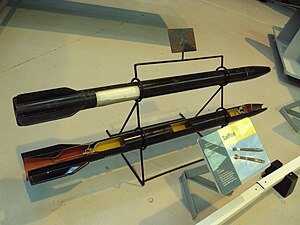| Taifun | |
|---|---|
 Two "Taifun" rockets displayed at RAF museum Cosford | |
| Type | Unguided anti-aircraft rocket |
| Place of origin | Germany |
| Production history | |
| Manufacturer | Flak-Versuchskommando Nord, EMW Peenemünde |
| Produced | January–May 1945 |
| No. built | Approx 600 |
| Specifications (Taifun F[1]) | |
| Mass | 21 kg (46 lb) at launch |
| Length | 1.93 m (6 ft 4 in) |
| Diameter | 10 cm (3.9 in) |
| Warhead | High Explosive |
| Warhead weight | 500 g (1.1 lb) |
Detonation mechanism | Contact Fuze |
| Propellant | Hypergolic Liquid |
| Flight ceiling | 15,000 meters (50,000ft) |
| Boost time | 2.5 secs |
| Maximum speed | >3,300 km/h (2,100 mph) (Obtained) |
Launch platform | Modified 8.8 cm Flak 18/36/37/41 |
Taifun (German for "typhoon") was a German World War II anti-aircraft unguided rocket system. Waves of small, relatively cheap, Taifun flak rockets were to be launched en masse into Allied bomber formations.[1] Although never deployed operationally, the Taifun was further developed in the US as the 76mm HEAA T220 "Loki" Rocket.
- ^ a b Hutcheon, I A (1946). German Non Guided Flak Rocket - Taifun (Report). Armaments Design Department, Ministry of Supply (UK). Archived from the original on 6 December 2020.